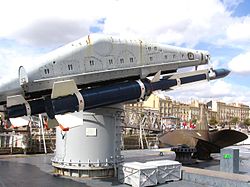- Masurca
-
Masurca 
Masurca missile on launcherType surface-to-air Place of origin  France
FranceService history In service 1968 Used by France Production history Designed 1960 Manufacturer ECAN Ruelle Produced 1966 Variants Mk1, Mk2 mod2 and Mk2 mod3 Specifications Weight 950 kg+1148kg including booster Length 5.38 m+3.32m booster Diameter 0.406 m Warhead 100 kilograms HE blast-fragmentation Detonation
mechanismproximity fuze Engine Matra solid rocket booster and sustainer Wingspan 0.770 m Operational
range55 km Flight ceiling 20,000-30,000 m Speed Mach 3.0 Guidance
systeminertial initial and Semi-active radar homing terminal Steering
systemcontrol surfaces Launch
platformship The Masurca missile was a first generation naval surface-to-air missile system developed and used by the French Navy. Planned as the primary air defence missile system of the first generation of French guided missile ships it was to be used only aboard the two Suffren-class destroyers and as a retrofit to the cruiser Colbert.
Contents
History
In 1948 France embarked on a number of programs to develop guided missile systems, the aim being to keep pace with the other Great Powers. The proliferation of high-speed threats be they underwater, surface or aerial threats required the development of effective defences. High priority programs were initiated to cover all areas: anti-aircraft, anti-surface and anti-submarine. Of these programs two achieved operational status, these were:
- MALAFON (MArine LAtécoère FONd i.e. Latécoère Naval underwater) for the anti-submarine role
- MASURCA (MArine SURface Contre-Avions i.e Naval surface anti-aircraft) for the area and high-priority air defense role
France had already been working on an anti-aircraft missile the Maruca, derived from the wartime German Henschel Hs 117 Schmetterling. Although the MARUCA program was ultimately abandoned because of impracticability, experience from its development would not go to waste.
In 1955 ECAN de Ruelle began work on a supersonic missile using solid-propellants. The MASURCA was a DTCN (Direction Technique des Constructions Navales i.e Naval Construction Department) program working through ECAN de Ruelle and Matra.
The first tests were made on the Île du Levant, the focus moving in 1960 to the Ile d'Oléron in a building especially built for experimentation. 50 test firings would be made in the period up to 1968, concluding with operational validation aboard the then newly commissioned frigate Suffren.
After the initial version, known as the Mark 1, came the Mark 2 which benefited from knowledge and technology transfer from the United States. France was in the process of modernising it's T 47 class fleet escorts and it received data from the RIM-2 Terrier program offered by the United States as equipment for the Dupetit-Thouars, and experience from the deployment of the RIM-24 Tartar aboard the Kersaint, Bouvet, and Du Chayla.
France subsequently developed the Mk2 mod2 (Mark 2 modification 2) which deployed from 1966. This was later improved to MK2 mod 3 standard in 1970, and was updated again between 1983 and 1985.
MASURCA had been intended as the principal weapon of France's first generation of guided-missile ships (known as FLE or frégates lance-engines in the French parlance of the time). Initially MASURCA was to have armed the six units of the Suffren class, however with the termination of the class at two ships, the only ships to ship with the system were Suffren, her sister-ship Duquesne and, in her incarnation as a guided missile, the cruiser Colbert.
Over time the number of missiles has declined with the winding down of the program and the retirement of is launch platforms. The Duquesne was placed into reserve in 2009 replaced by the air-defence destroyer Forbin.
System characteristics
The missile
The complete missile weighed over two tonnes composed of two stages joined by pyrotechnic fasteners (designed to separate the two stages when the propellant in the first had been exhausted). The missile had a range of 55 km and possessed a large, for an anti-aircraft weapon, 100kg HE blast fragmentation warhead. This was perhaps to overcome shortcomings in accuracy as, coupled with a proximity fuse, any aircraft the missile failed to hit could still be caught in its blast.
The booster was designed to expend all its fuel in about 5 seconds, accelerating the missile to a velocity of 800 meters per second (2880 km / h about mach 2.7) on separation. After separation of the two stages, and the missile was heading towards the target at a terminal velocity of Mach 3, the terminal radar guidance system was initiated.
This mode of operation meant that the missile had a minimum intercept altitude of 30 m which in theory left it unable to intercept sea skimming anti-ship missiles and low flying aircraft. However even blind the 100 kg warhead meant that some result would have been achieved.
MASURCA was manufactured in three versions:
- The Mark 1: this was a basic version, it was used during all qualification tests but also for a time aboard the Suffren.
- The Mark 2 Mod 2: this was the first operational version. This relatively primitive version was retired in 1975.
- The Mark 2 Mod 3: this was the last operational version.
References
- This article's content is based on that from the corresponding article on the French Wikipedia.
Categories:- Guided missile stubs
- Naval surface-to-air missiles of France
Wikimedia Foundation. 2010.
